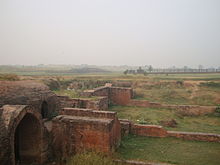Thanesar
Thanesar
Sthanishvara | |
|---|---|
City | |
| Thanesar city or Sthanishwar city | |
UTC+5:30 (IST) | |
| Vehicle registration | HR |
| Website | haryana |
Thanesar (also known as Sthanishvara) is a historic city and Hindu pilgrimage centre in the Kurukshetra district of Haryana, India. It is located approximately 160 km northwest of Delhi. The city Kurukshetra's area merges with Thanesar.[2][3]
Thanesar was the capital of the
History

Present-day Thanesar is located on an ancient mound. The mound (1km long and 750m wide) is known as Harsh ka Tila (Mound of Harsha). It has ruins of structures built during the reign of
In the post-Gupta period, Sthanishvara was the capital of the
Thanesar is listed in the
Majority of architectural remains including Karavan serai, cells, and various arched and vaulted structures date from the Mughal period. Building remains of a large palatial structure from the pre-Islamic era were also found with two distinct phases of construction which exposed brick covered drains and rooms situated around a central courtyard.[9]
Sack of Sthaneshwar by Mahmud of Gazni
Thanesar was sacked and many of its temples were destroyed by Mahmud of Ghazni in 1011.[10]
'The city of Taneshar is highly venerated by Hindus. The idol of that place is called Cakrasvamin (Chakra Swami), i.e. the owner of the cakra, a weapon that we have already described. It is of bronze and is nearly the size of a man. It is now lying in the hippodrome in Ghazna, together with the Lord of Somnath, which is a representation of the Mahadeva, called Linga."[11]
In the year A.H. 402 (A.D. 1011) Mehmood Gazini resolved on the conquest of Thanesur, the most sacred Hindu place, in the kingdom of Hindoostan. It had reached the ears of the King that Thanesar was held in the same veneration by idolaters, as Mecca by the faithful; that they had there set up a number of idols, the principal of which they called Jugsoma, pretending that it had existed ever since the creation.
Mahmud, having reached Thanesar before the Hindus, had time to take measures for its defence; the city was plundered, the idols broken, and the idol Jugsoma was sent to Ghazni to be trodden underfoot. According to Haji Mahommed Kandahary, a ruby was found in one of the temples weighing 450 mithqals. It was allowed by everyone who saw it to be a wonder that had never been heard of. About the attack on Thanesar, Utbi wrote "The blood of the infidels flowed so copiously that the stream was discoloured, notwithstanding its purity, and people were unable to drink it."[13]



British era
For their participation in
Geography
Thanesar is located at 29°58′N 76°49′E / 29.967°N 76.817°E.[15]
Demographics
The 2011 census of India noted that Thanesar had a population of 154,962.[16][1] Males constituted 55% of the population and females 45% (83,655 – 71,307). Thanesar had an average literacy rate of 85.73%, higher than the national average of 74.04: male literacy is 89.89%, and female literacy is 80.85%.[1] In Thanesar, 12% of the population is under 6 years of age.
Tourism

Religious

Thanesar derives its name from the word Sthaneshwar which means "place of god." The
See also
References
- ^ a b c "Cities having population 1 lakh and above, Census 2011" (PDF). Census of India, 2011. p. 1. Retrieved 9 August 2014.
- ISBN 978-0-8239-3180-4.
- ^ a b "Sthanvishvara (historical region, India)". Encyclopædia Britannica. Retrieved 9 August 2014.
- ISBN 978-981-4311-67-0.
- ^ a b "Sheikh Chilli's Tomb, Thanesar". Archaeological Survey of India. Retrieved 9 August 2014.
- ^ "Harsh Ka Tila". Kurukshetra district website. Retrieved 8 August 2014.
- ^ "Harsha (Indian emperor)". Encyclopædia Britannica. Retrieved 9 August 2014.
- ^ Abu'l-Fazl ibn Mubarak; Jarrett, Henry Sullivan (1891). The Ain-i-Akbari. Calcutta: Asiatic Society of Bengal. p. 296. Retrieved 21 January 2021.
- ^ Pande, B.M. (2016). textsThanesar. Archaeological Survey of India. pp. 19–21.
- ^ "Kurukshetra (India)". Encyclopædia Britannica. Retrieved 9 August 2014.
- ^ Abu Rihan Muhammad bin Ahmad al-Biruni al-Khwarizmi, Tarikhu'l-Hind
- ^ Farishta Vo1. Page 29 Translation by John Briggs.
- ^ Elliot, Henry M. (1869). "The History of India".
- ^ Mittal, Satish Chandra (1986). Haryana, a Historical Perspective. Atlantic Publishers & Distri.
- ^ "Maps, Weather, and Airports for Thanesar, India". www.fallingrain.com. Retrieved 5 November 2023.
- ^ "Census of India 2001: Data from the 2001 Census, including cities, villages and towns (Provisional)". Census Commission of India. Archived from the original on 16 June 2004. Retrieved 1 November 2008.
- ISBN 978-81-8495-170-7.
- ISBN 978-81-8324-129-8.
- ^ Narkatari Kurukshetra district website.
Bibliography
- F. W. Thomas. London : Royal Asiatic Society.
External links
 Media related to Thanesar at Wikimedia Commons
Media related to Thanesar at Wikimedia Commons




